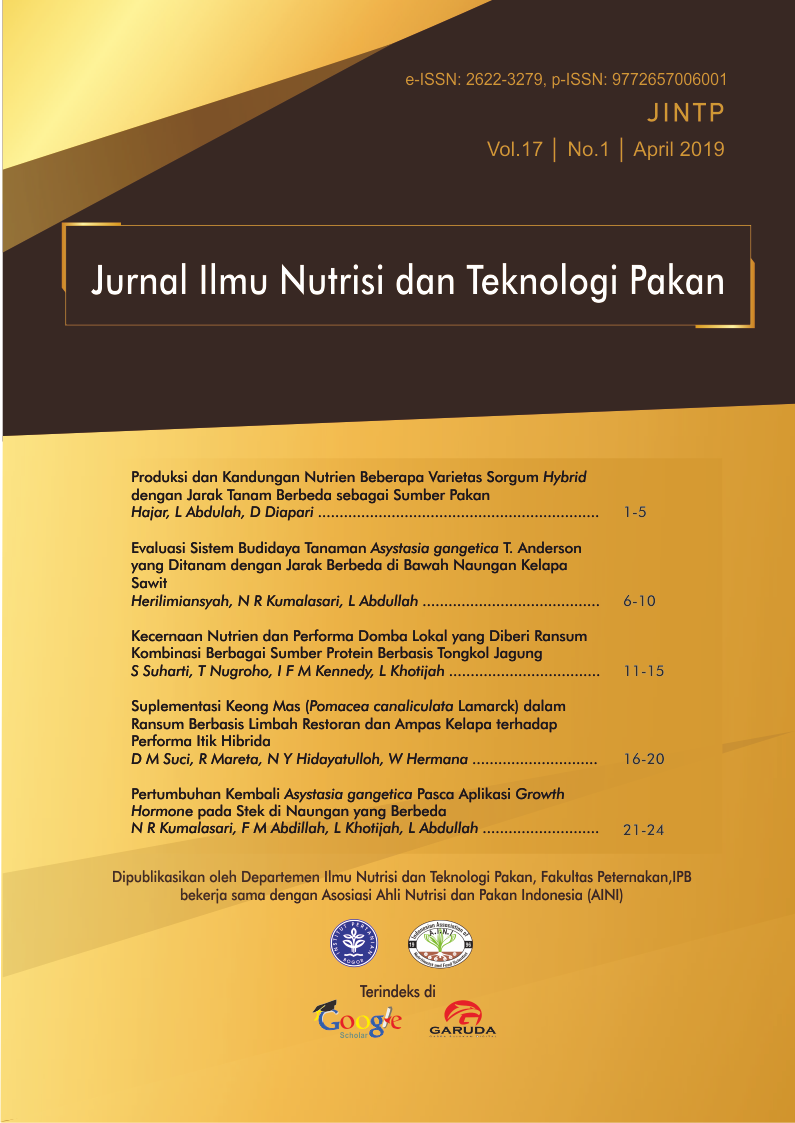Evaluasi Sistem Budidaya Tanaman Asystasia gangetica T. Anderson yang Ditanam dengan Jarak Berbeda di Bawah Naungan Kelapa Sawit
Abstract
The objective of this experiment was to evaluate the cultivation, production and quality systems of Asystasia gangetica T. Anderson as forage in palm oil plantations. This research was arranged in a factorial randomized block design with 2 factors, i.e. palm plantation ages (6 and 8 years old) and different plant spacing (10x10 cm, 25x25 cm, and 40x40 cm). Variables observed were plant height, number of leaves, number of primary and secondary branches, leaf length and width, biomass production, and nutrient contents. Spacing was significantly affected (p<0.05) on increasing height plant, number of primary and secondary branches, number of leaves, leaf width and length, and biomass production. The spacing also has a significant effect (p<0.05) on nutrient content such as dry matter and crude fiber. The heighest plants average at plant spacing of 10x10 cm was 66.19 cm, the best number of primary and secondary branches at spacing of 25x25 cm were 2 and 10 branches, the average number of the best number of leaves at spacing of 25x25 cm was 80 leaflets, leaveslength and width at spacing of 10x10 cm were 12.49 and 4.29 cm, while the best biomass production at spacing of 10x10 cm was 2766 g. The research concluded that in order to obtain high crop production, the best plant spacing was 10x10 cm under 6 years old of palm plantation, whereas the best nutrient quality was on 25x25 cm spacing.
Keywords: Asystasia, Forage, nutrient content, plant spacing
Downloads
References
Adetula OA. 2004. Asystasia gangetica (L.) Anderson. Record from PROTA4U. Grubben GJH and Denton OA (Editors). PROTA (Plant Resources of Tropical Africa /Ressources végétales de l’Afrique tropicale), Wageningen, Netherlands. www.prota4u.org/search.asp.
Alvarez CGD, Pinho RG & Borges ID.2006. Evaluation of agronomic characteristics and production of forage and grains of corn in different densities of sowing and row spacings. Ciência & Agrotecnologia 30 (3) : 402–408. doi:10.1590/S1413-70542006000300003
Andrieu N, Vayssières J, Corbeels M, Blanchard M, Vall E &Tittonell P. 2015. From farm scale synergies to village scale trade-offs: cereal crop residues use in an agro-pastoral system of the Sudanian zone of Burkina Faso. Agricultural System. 134(C): 84-96.
AOAC. 2005. Official Methods of Analysis. of AOAC International. The 8th Edition. Maryland (US): AOAC International.
Asbur Y, Yahya S, Murtilaksono K, Sudrajat & Sutarta ES. 2015. The role of cover crop against nutrient balance at mature oil palm plantation at South Lampung. International Journal of Sciences : Basic and Applied Research. 23: 53-60.
Asbur Y, Yahya S, Murtilaksono K, Sudrajat & Sutarta ES. 2016. The roles of Asystasia gangetica (T) Anderson and ridge terrace in reducing soil erosion and nutrient losses in oil palm plantation in South Lampung, Indonesia. Journal of Tropical Crop Science 3 (2) :49-55.
Banurea DP, Abdullah L & Kumalasari NR. 2017. Evaluasi produksi biomassa dan karakteristik tajuk Indigofera zollingiriena pada jarak tanam yang berbeda. Buletin Makanan Ternak 104 (2) : 1-11.
Bonner, J. 1965. Plant Biochemistry. New York: Academic Press.
Borghi E, Crusciol CAC, Nascente AS, Mateus GP, Martins PO & Costa C. 2012. Effects of row spacing and intercrop on maize grain yield and forage production of palisade grass. Crop & Pasture Science. CSIRO Publishing.
Daru P Taufan, Yulianti A &Widodo E. 2013. Potensi hijauan di perkebunan kelapa sawit sebagai pakan sapi potong di Kabupaten Kutai Kartanegara. Pastura 3 (2) : 94 – 98.
Demétrio CS, Fornasieri Filho D, Cazetta JO & Cazetta DA. 2008. Performance of maize hybrids submitted to different row spacing and population densities. Pesquisa Agropecuaria Brasileira 43 (12) : 1691–1697.
Direktorat Jenderal Perkebunan. 2016. Statistik Perkebunan Sawit. Kelapa Sawit. Jakarta.
Goering HK, Van Soest PJ. 1970. Forage fiber analysis (appartus, reagents, procedures and some application). Us dep. Agric. Handb
Gopal TK, Megha G, Chamundeeswari D & Umamaheswara RC. 2013. Phytochemical and pharmacological studies on whole plant of Asystasia gangetica. Indian Journal of Research in Pharmacy and Biotechnology 1(3) : 365-370.
Homann-Kee Tui S, Valbuena D, Masikati P, Descheemaeker K, Nyamangara J, Claessens L, Erenstein O,Van Rooyen A & Nkomboni D. 2015 .Economic trade-offs of biomass use in crop-livestock systems: exploring more sustainable options in semi-arid Zimbabwe. Agricultural System. 134 : 48-60.
Karima SS, Nawawi M & Herlina N. 2013. Pengaruh saat tanam jagung dalam tumpangsari tanaman jagung (Zea mays L.) dan brokoli (Brassica oleracea L. var. botrytis). Jurnal Produksi Tanaman 1(3) : 87-92
Kumalasari NR, Wahyuni L & Abdullah L. 2018. Germination of Asystasia gangetica seeds exposed to different source, color, size, storage duration and pre-germinative treatments. Di dalam : Sudarman A, Takahashi J, Pitchford W, Ludema MW, Lozicki A, Despal, editor. Sustainable Animal Production for Food Security and Safety. The 4th International Seminar on Animal Industry [Internet]. 2018 August 28-30; Bogor (ID). Hlm 130 -134; (diunduh 2018 Des 20). Tersedia pada :http://isai.ipb.ac.id/proceeding?field_year_of_seminar_tid=884&keys=.pdf
Mattjik AA & Sumertajaya IM. 2013. Perancangan Percobaan dengan Aplikasi SAS dan Minitab. IPB Press. Bogor.
Mugabo R & Raji IA. 2013. Effects of aqueous leaf extract of Asystasia gangetica on the blood pressure and heart rate in male spontaneously hypertensive wistar rats. BMC Complementary and Alternative Medicine 13(283): 1-7.
Preston, T R & Leng RA. 1987. Matching Ruminant Production System with Available Resources in the Tropics and Sub-tropics. Penambul Books, Armidale, Australia. Pp 161 -180.
Priwiratama H. 2011. Informasi organisme tanaman pengganggu ; Asystasia gangetica (L.) subsp. micrantha (Nees). Pusat Penelitian Kelapa Sawit, vol. G-0001: 1-2.
Pradnyawan, S.W.H., W. Mudyantini, Marsusi. 2005. Pertumbuhan, kandungan nitrogen, klorofil dan karotenoid daun Gynura procumbens [Lour] Merr. Pada tingkat naungan berbeda. Biofarmasi. 3:7-10.
Samedani B, Juraimi AS, Anwar MP,Rafii MY, Awadz SH & Anuar AR. 2013. Competitive interaction of Axonopus compressus and Asystasia gangetica under contrasting sunlight intensity. The Scientific World Journal 2013 : 1-8
Sandoval JR & Rodriguez PA. 2012. Asystasia gangetica (chinese violet). Washington DC (US): Department of Botany-Smithsonian NMNH.
Sari DM, Sembodo DR & Hidayat KF. 2016. Pengaruh jenis dan tingkat kerapatan gulma terhadap pertumbuhan awal tanaman ubikayu (Manihot esculenta Crantz) klon Uj-5 (Kasetsart). Jurnal Agrotek Tropika, 4(1) : 1-6.
Savitri MV, Sudarwati H & Hermanto. 2012. Pengaruh umur pemotongan terhadap produktivitas gamal (Gliricidia sepium). Jurnal Ilmu – Ilmu Pertanian 23(2) : 25-35
Sudirman, Suhubdy S, Hasan. SD, Dilaga SH & Karda. I W. 2015. Kandungan Neutral (Detergent Fibre (NDF) dan Acid Detergent Fibre (ADF) Bahan Pakan Lokal Ternak Sapi yang Dipelihara pada Kandang Kelompok. Jurnal Ilmu Teknologi Peternakan Indonesia 1(1): 77- 81.
Van soest PJ, Robertson JB & Lewis BA. 1991. Methods for dietary fiber, neutral detergent fiber, and non-starch polysaccharides in relation to animal nutrition. Journal of Dairy science. 70: 2063.
The authors of the submitted manuscript have to understand and agree that the copyrights published are held by Jurnal Ilmu Nutrisi dan Teknologi Pakan. Copyrights includes rights in reproducing, distributing and selling every section of articles in all forms and media. The copyright transfer form is signed by the corresponding author. The author”
• Creative Commons Attribution (CC BY)
you are allowed to:
Share – copy and redistribute the material in any medium or format
Adapt – remix, transform, and build upon the material
for any purpose, even commercially.
The licensor cannot revoke these freedoms as long as you follow the license terms.
Jurnal Ilmu Nutrisi dan Teknologi Pakan (Nutrition and Feed Technology Journal)

This work is licensed under a Creative Commons Attribution 4.0 International License.












